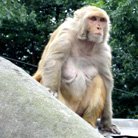After spending a day finalizing the agenda for my last week in Kathmandu, I got back in the swing of administrative duties, which was rather tough after the somewhat slow pace of life in Achham. Today’s agenda, however, took me through some areas that made me realize that there was inequity in the cities as well.
My first stop was the Nepal Medical Council, found all the way across town in Bansibar, Maharajgunj. For some reason, there was a massive traffic jam in central Kathmandu, so my cabbie made me a deal: he would work for a flat fee if he were allowed to take the side streets to save time. One of the rules of Nepalese city life (for foreigners, at least) is to go by taxi meter, but given the circumstances, I agreed. Doing so, he took the backroad (road is a relative term here—it was basically an unpaved rock path) that followed on the banks of the muddiest, brownest river I had ever seen. Trash literally made of several of the banks, and an overwhelming stench of waste (both industrial and human) hit me full-on. Nevertheless, hundreds of people were still making a living here. Young men waded in the shallows with nets, trying to catch something (I couldn’t believe anything could possibly survive in that river), while old women washed their clothes in the putrid water. Children splashed each other on the banks, shadowed by tin-and-cardboard shanties that looked like they may fall over at any moment.
“I asked to come this way because you told me you’d been in Nepal for a while,” said the cabbie, noticing that I was staring. “I usually don’t take foreigners this route.”
We then veered back onto the main road through a winding alleyway, and I was amazed by the sudden transformation. Bansibar is where many of the major embassies (French, Australian, Japanese) and organizational centers (Councils of Medicine, Nursing, Water) are, and the neat row of houses, sparkling government buildings, and shops were a stark contrast to the poverty omnipresent less than half a kilometer away.
Anyways, after doing some business at the Nepal Medical Council (okay, okay, I was getting documentation and applications so that we could bring in several expatriate doctors to work at the clinic) I took another cab to Patan Hospital to track down Rachanal Shretha, the director of the birthing center there (which is famous for reasons I’ve enumerated in a previous post). Nobody seemed to know where she was, so I took a stroll down the pediatric wards (for some reason, if you drop by in the afternoon, the security doesn’t seem to care if you just wander around the patient wards). In the words of Sachin, my pediatrician ex-housemate, “there were a lot of sick kids.” Many seemed quite cheerful though, and two with casts were actually playing with a ball in the courtyard.
This made me think that sometimes, I wish I could go back to being a small child. There’s a pure optimism kids have that we don’t anymore. Granted, as a young person, I’m still overly a glass-half-full person, but I can’t always believe that the best will come around. Bless them for it, I suppose.
